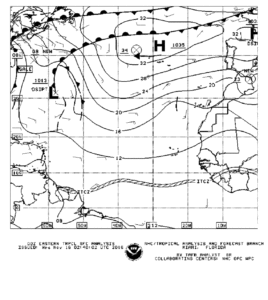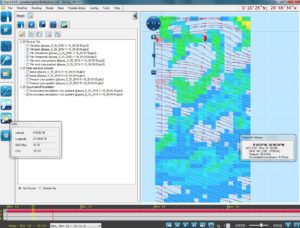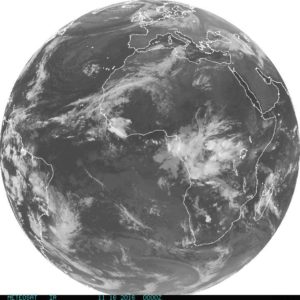Last night I was back at it trying to understand our downwind sails. We have a truly enormous masthead gennaker, about 370 square meters (3700 square feet). Yet somehow it doesn’t seem always effective. Finally I came up with a theory as to why.
The front 3 or 4 feet of the sail are very full (rounded). And so regardless of how much you pull in the sail, to try to correct the inevitable luffing, you can’t do it. The result therefore is that the rest of the huge sail is incorrectly trimmed. Last night, going downwind, I trimmed the rest of the sail, letting it way out as we were broad reaching, and the luff still luffed at the front, but the rest of the sail was happy, and so our speed was much happier too (as was the skipper therefore!)
We’ve been lining up our approach to the doldrums, aiming, as many of the others seem to be, at 7/30N and 27/30W. This is the point recommended by Jean-Yves Bernot as a starting target, and then to modify as conditions develop.
The ITCZ (Intertropical Convergence Zone) is where the two hemispheres, and their weather systems, meet. There is vast turbulence as these hemispheric wide forces come together. In the north, high pressure systems rotate clockwise, in the south, counterclockwise, and the low pressure systems are similarly opposite.
There can be rain squalls, squalls, calms, light winds, heavy winds, torrential downpours and conditions entirely different from what any forecast is so bold as to predict. See below for several of the data inputs that I use to try to understand where to go to get across as quickly as possible.
- Weather Map
- Squid Weather Software
- Weather Map
Position
9° 37’N x 27° 29’W
Course
176° True
Speed
8.3 knots
True Wind Speed
6.7 knots
True Wind Direction
078°
Sail Plan
Genoa plus full Mainsail
Air temperature
81°F / 30°C
Sea Temperature
85° F
| Winch Pedestal Revolutions (daily) | Amp Hours: Alternator (total) | Amp Hours: Solar (total) | Amp Hours: Hydro (total) | Amp Hours: Wind (total) |
| 2097 | 1069 | 108 | 1901 | 415 |



